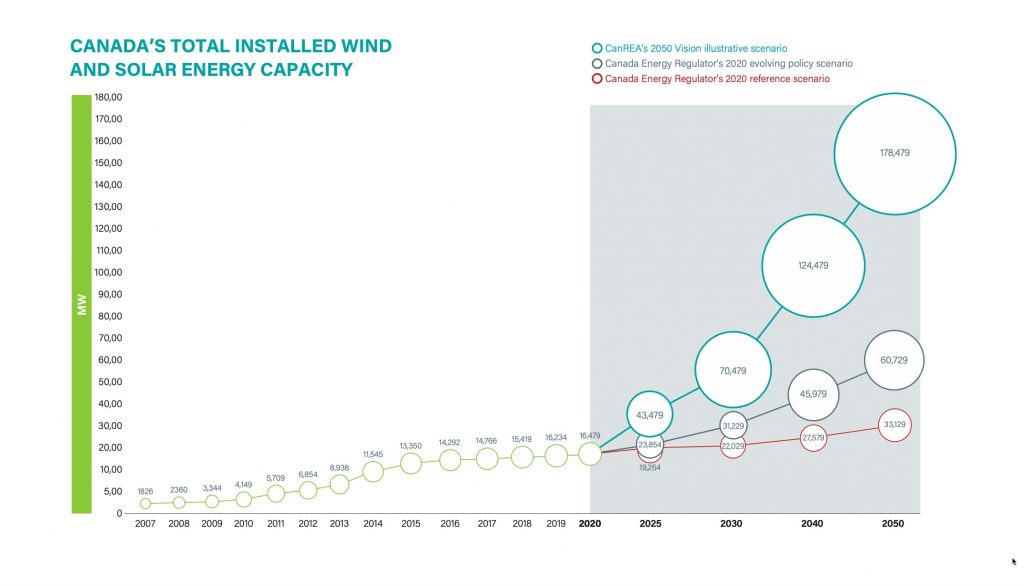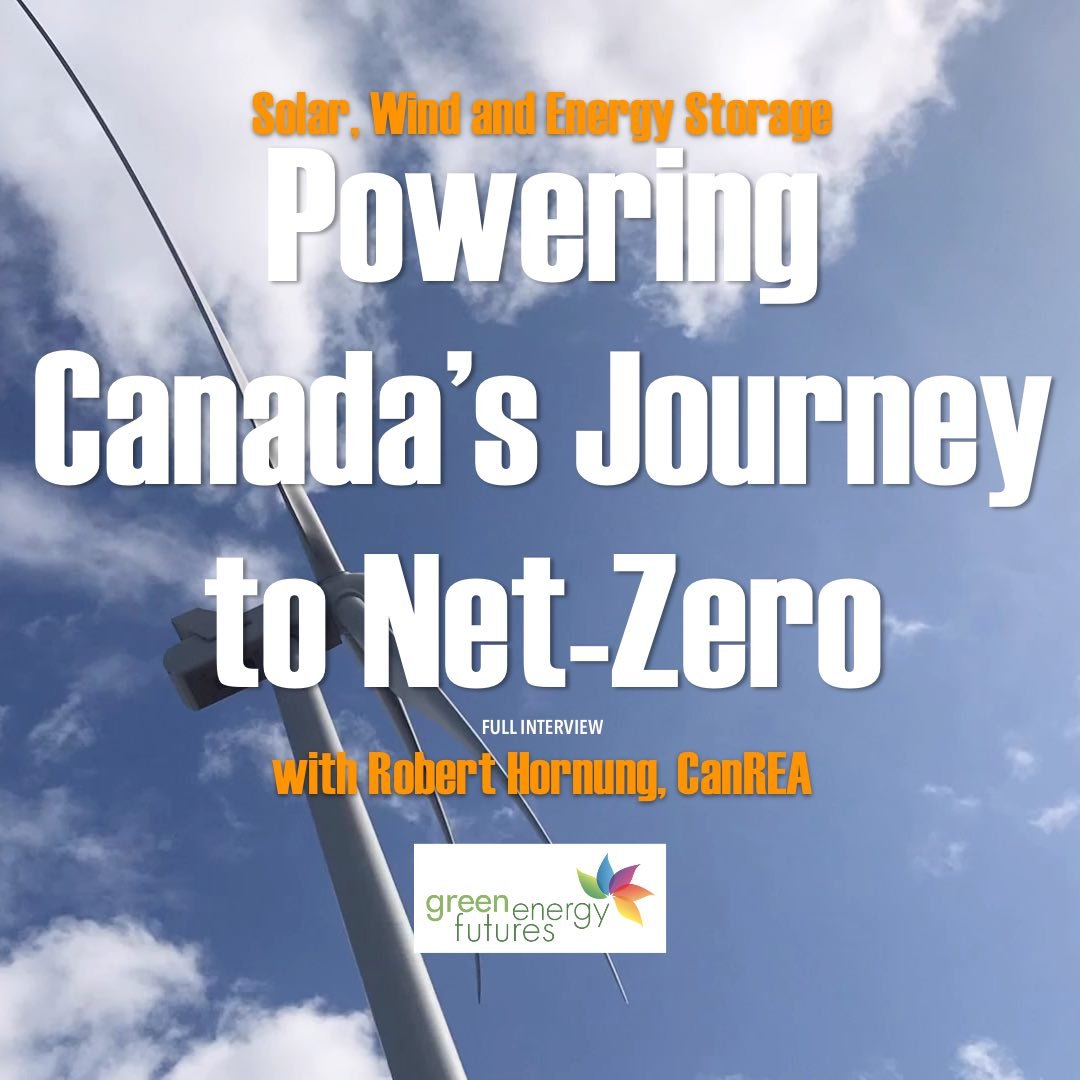By David Dodge, GreenEnergyFutures.ca
Canada wants to reach net-zero greenhouse gas emissions by 2050 which means every sector including transportation, buildings and industry must also reach net-zero.
Canada’s electricity grid is the root directory of the Canadian economy – it will be very hard for other sectors to reach net-zero if the electricity they use produces carbon emissions.
The Canadian Renewable Energy Association (CanREA) has just produced a report that says solar, wind and energy storage are the most economical way to decarbonize the grid and help Canada reach its net-zero goals. The report is entitled “Powering Canada’s Journey to Net-Zero.”
“Today 80% of our electricity comes from non-emitting sources. And we’ve also seen a dramatic reduction in emissions from the electricity sector – 48% reductions since 2005, largely due to the phase-out of coal in Ontario,” says Robert Hornung, President, and CEO of CanREA.
Canada is in an enviable position among G7 Countries having among the highest proportion of decarbonized electricity today.
Renewable energy? Double-double please
Canada not only needs to decarbonize the remaining 20% of its electricity grid “all the research says we probably need to double the size of our electricity grid to get to net-zero,” says Hornung.
This is because of the push to “electrify everything.” Virtually the entire auto industry has moved its investment to electric vehicles. Climate plans in cities, states and countries are calling for radically improved energy efficiency in buildings and the use of electric heat pumps to heat them – all in we’ll need twice as much electricity.
“We know that wind and solar are the lowest-cost sources of new electricity and will be through 2050. Therefore, that’s going to represent the biggest chunk of new generation that comes forward,” says Hornung.
Bloomberg predicted in 2019 that 77% of all new investment in power generation globally will be in renewables, principally solar and wind through to 2050.
For Canada to decarbonize its existing grid and satisfy increased demand using renewable energy Hornung says “We need to build about 3,800 megawatts of wind and about 1,600 megawatts of solar capacity every year for the next 29 years.”
This represents a ten-fold increase in solar and wind. In the end non-hydro renewable energy would supply about one-third of Canada’s total electricity.
Solar and wind are booming now, but this pace needs to ramp up 10-fold which Hornung says will require modernization of electricity markets, regulatory regimes, and strategic lowest-cost upgrades to the electricity system.
Grid evolution – from one-way system to a smart grid matrix
Canada’s electricity system was designed as essentially as a one-way street. Build large power plants, hydro dams, and transmission wires and deliver the electricity to consumers.
The grid must now transform into a two-way, interactive system with energy producers and energy storage distributed throughout the system, big and small.
In Alberta alone, the grid has gone from about a dozen electricity producers 20 years ago to more than 7,000 today as companies and individuals embrace solar and wind power.
Add to this mix electric vehicles, energy storage, smart grid technologies, smart home technologies, and a host of other innovations and you can start to visualize the future grid as a matrix of energy generation, energy storage, and consumption.
The challenge is many of the policies and market structures in place today were not designed to accommodate these innovations and act as barriers to innovation.
“We need to restructure our market frameworks, our regulatory frameworks, to ensure that all technologies that can provide services that contribute to the reliability of the system have an opportunity to do that,” says Hornung.
Consider energy storage. It’s fast becoming more economical and it’s a way to store solar and wind energy for use when the sun isn’t shining, or wind isn’t blowing.
But in Alberta for example there is an “energy-only” market where the only thing the grid will pay for is electricity produced.
Weaving non-wires, energy services into the grid matrix
The grid of the future needs an array of services and it appears Alberta is starting to respond.
“The Alberta government has introduced new legislation, which for the first time seeks to define energy storage in legislative terms … that will allow it to participate in these markets,” says Hornung.
“There are now 2,500 megawatts of energy storage projects proposed in Alberta waiting for the finalization of this regulatory framework so that they can come in and provide these services that will enable Alberta to continue to grow its renewable energy base in wind and solar.”
Smart home of the net-zero future
A company in Montreal, DCBel manufactures an all-in-one smart home device of the future. It’s a DC vehicle charger, a solar inverter, and an AI-powered energy management device for homes. It works bi-directionally with your electric vehicle and could isolate and power your home in a blackout.
Canada’s electricity market structure and regulations are not ready for devices like this.
Instead, the device is being sold in California, New York, and Texas where EV and solar penetration is higher and the grid is already in trouble.
Electric vehicles, even at small levels of penetration are massive energy storage devices that if leveraged could provide grid reliability services using infrastructure paid for by consumers and not grid managers.
EVs and smart technologies “are going to play a really important role, but being able to capitalize on them will require some of the market and regulatory reform we talked about. It will also require, changes in the way we operate the electricity system,” says Hornung.
Removing barriers attracts billions in investment
Removing barriers to new innovative smart technologies is one step, but adopting modern policies that remove barriers to renewable energy is equally important.
Many provinces are still dominated by monopolies which is one challenge. But we can probably thank Ontario for pioneering feed-in-tariffs that kick-started the renewable energy industry in Canada, but we must look to Alberta for the policies that get out of the way and allow renewable energy to flourish.
Alberta’s so-called deregulated market is not perfect, but it does allow companies to build renewable energy projects based on economics and market forces.
If you are a renewable energy developer and you can see the potential for revenue “You are able to connect. You are able to go forward,” says Hornung.
The same is true for consumers in Alberta if you find the right price and want to buy renewable energy no problem.
This has led to a solar and wind power boom in Alberta.
Claresholm the largest solar project in Canadian history at 132 megawatts came on stream earlier this year. And now Greengate Power out of Calgary is building the massive 465-megawatt Travers Solar project near Vulcan, Alberta.
And that project caught the attention of the world’s largest company, Amazon which has already bought most of the energy from that project in a long-term purchase agreement.
Big companies need clean energy too.
“And in fact, when the deal was announced in Alberta, that Amazon was purchasing this power, they made it very explicit that one of the reasons that they are interested is due to the structure of the Alberta market that allows that,” says Hornung.
That renewable energy agreement was soon followed by the announcement of a $4.3 billion cloud computing hub in Alberta. Hornung says these two things line up, the availability of clean energy and the company’s decision to build and operate there as well.
Transmission – sharing is best
Transmission infrastructure is “expensive” and “we’re going to need to build new transmission,” says Hornung. But the focus, says Hornung should stay laser-focused on the lowest cost solutions for getting to net-zero.
This means using all of these new technologies to reduce peaks in electricity demand to get more use out of existing transmission lines.
It also means expanding transmission but only in very strategic ways.
Canada has ten provinces with ten electricity systems and although each operator has worked hard to optimize their systems “The one thing we’re sure of is that nationally we have a suboptimal outcome because we ignore all the possibilities for collaboration,” says Hornung.
In Canada, we have provinces with carbon-intensive grids right next door to provinces with emissions-free electricity. There are tremendous opportunities through interconnection and coordinated management to accommodate much more renewable energy and run a much more efficient grid, says Hornung.

Canada’s net-zero grid todo list
Disruption, distributed energy, smart technologies, and electric vehicles are all coming to the only question is whether grid operators will be proactive or wait for grids to crash before adapting to them.
Renewable energy is the cheapest already, and the investment is coming, but the pace needs to ramp up quickly.
CanREA says this will require not only the market, policy, and regulatory changes and improvements to transmission, but it will also require a commitment at the highest levels to focus our efforts.
CanREA would like to see the electricity system decarbonized by 2035.
They are also asking for two things: 1) the implementation of “a clean electricity standard federally” that requires the reduction of greenhouse gas emissions down to zero by 2035. And 2) that carbon pricing is fully applied in the electricity sector right now, to existing natural gas plants in Canada that are largely sheltered from the carbon price.”
Like Ontario did almost a decade ago, Alberta is now on track to shutter all of its coal generation plants by 2023, well ahead of schedule. Thanks to coal shutdowns and growth in renewable energy Ontario reduced electricity emissions by 40 megatonnes in 20 years. Alberta will accomplish this level of reduction in just 10 years.
In short, huge gains have been made reducing emissions from electricity generation in Canada. However, what’s unclear is how much of the coal generation will be replaced by gas in Alberta. There is some concern that by investing too heavily in natural gas generation Alberta will lock in emissions from gas-fired generation.
With increasing pressure to reduce emissions, exposure to rising carbon taxes and the high cost of carbon capture and storage gas may present risks to Alberta and to the bigger goal of getting to net-zero.
“Every model that looks at net-zero greenhouse gas emissions does envision a role for natural gas,” says Hornung, but it may be best suited for higher-value services to the grid, where the economics of carbon capture and storage makes sense.
The journey to net-zero is one that will take us down along a winding road, with risks at every turn. But on the glass half full side of this road are the simple realities that renewable energy is cheapest and getting cheaper, energy storage, electric vehicles, and smart technologies are ready to play a big role and despite the enormity of the challenge, the economics just might be on the side of building the low to no emissions grid of the future we need.

